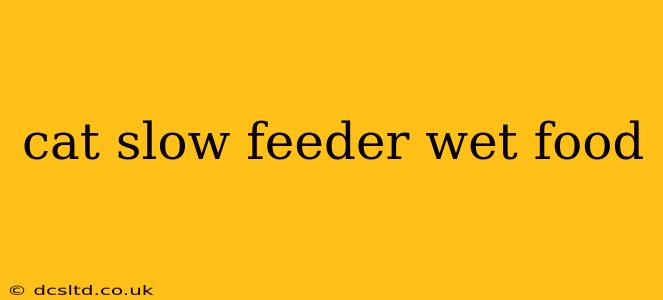Many cat owners face the frustrating challenge of their feline friends gobbling down their wet food in record time. This isn't just inconvenient; it can lead to digestive issues, vomiting, and even obesity. Enter the cat slow feeder bowl specifically designed for wet food – a game-changer for both cat and owner. This comprehensive guide will explore the benefits of slow feeders for wet food, address common questions, and help you choose the right one for your furry companion.
Why Use a Slow Feeder for Wet Food?
The benefits of using a slow feeder bowl extend beyond simply slowing down your cat's eating pace. These innovative bowls are designed to mimic a cat's natural hunting and foraging instincts, making mealtime more stimulating and enjoyable. This is especially important for wet food, as its smooth texture often doesn't provide the same level of challenge as dry kibble.
Benefits include:
- Improved Digestion: Slow eating prevents gulping and air intake, reducing the risk of vomiting and gas.
- Weight Management: By extending mealtime, slow feeders help cats feel fuller for longer, contributing to healthy weight maintenance. This is particularly crucial for cats prone to obesity.
- Reduced Choking Hazards: Slow feeders minimize the risk of your cat choking on their food.
- Enriched Mealtime: The puzzle-like nature of many slow feeders provides mental stimulation, keeping your cat engaged and entertained during meals.
- Healthier Teeth and Gums: The action of working for their food can help clean teeth and massage gums.
What Types of Slow Feeder Bowls are Best for Wet Food?
Not all slow feeders are created equal. While many are designed for dry food, several are specifically adapted for wet food, and some work well for both. Here’s a breakdown:
- Lick Mats: These flat mats with various textures allow you to spread wet food across the surface, encouraging licking and slow consumption.
- Puzzle Feeders: These often have compartments or mazes that require your cat to work for their food. Look for ones with larger openings to accommodate wet food consistency.
- Elevated Bowls: While not strictly a "slow feeder," elevating the bowl can aid digestion and comfort for cats with neck or joint issues. The slower eating often results from the changed feeding posture.
- Slow Feeder Bowls with Raised Sections or Obstacles: These create a challenge for your cat, making them work for their food more than a standard bowl would.
Choosing the right bowl depends on your cat's personality and eating habits. Start with a simpler design and gradually introduce more challenging options if needed.
How Do I Introduce a Slow Feeder to My Cat?
Introducing a new feeder should be a gradual process to avoid stressing your cat.
- Start Slowly: Introduce the slow feeder gradually, mixing some regular food with the food placed in the slow feeder.
- Supervise: Initially, supervise your cat's mealtime to ensure they are comfortable with the new bowl.
- Positive Reinforcement: Reward your cat with praise or treats for successful feeding sessions.
- Observe and Adjust: Pay attention to your cat's behavior and adjust the difficulty level of the feeder as needed. If they are struggling, consider a less challenging option.
Can I Use Any Slow Feeder Bowl with Wet Food?
While some slow feeders are designed for dry food only, many can accommodate wet food. However, some designs might not be ideal for wet food. For example, very small compartments might be difficult for wet food to reach, and some materials might retain odors and bacteria from wet food if not cleaned properly. Look for slow feeders specifically designed to work with wet food or ones that have large openings and are easy to clean.
How Often Should I Clean My Cat's Slow Feeder Bowl?
Cleaning your cat's slow feeder bowl is crucial for maintaining hygiene and preventing bacterial growth, especially when using wet food. Thorough cleaning after every meal is recommended. This means hand-washing with soap and hot water, or cleaning in a dishwasher if the material allows.
What Are the Best Materials for Wet Food Slow Feeders?
Durable, easy-to-clean materials are best for wet food slow feeders. Stainless steel, silicone, and some hard plastics are excellent choices. Avoid materials that are porous or difficult to sanitize.
By choosing the right slow feeder and introducing it gradually, you can help your cat enjoy a healthier, more fulfilling mealtime, leading to a happier and healthier cat. Remember to always supervise your cat during their first few meals with a new slow feeder to ensure they're comfortable and adapting well.
